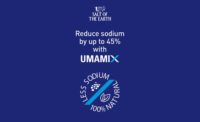Processors and researchers alike have been working on reducing sodium in meat and poultry products for years now and have achieved significant results. This is not without its challenges, though.
The use of salt in meat and poultry products is based primarily on the effects associated with three key functional properties. First, it solubilizes the meat’s myofibrillar proteins and interacts with them, leading to increased moisture and fat binding, explains Rodrigo Tarté, assistant professor of meat science in the Department of Animal Science at Iowa State University in Ames. Secondly, as is well-known, it acts as a flavor enhancer. Thirdly, sodium has significant antimicrobial activity, which leads to improved safety and increased shelf stability. Salt can also act in synergy with nitrite to augment its antimicrobial effectiveness.
In most traditional processed meat and poultry products, approximately 90 percent of the sodium can be provided by salt (sodium chloride), sodium lactate and sodium phosphates. Therefore, early sodium reduction strategies were geared at reduction or replacement of these three ingredients, Tarté explains.
“However, simple reduction, while practically simple to do, can be technically challenging as it almost always leads to a decrease in the magnitude of these ingredients’ important functional contributions and, hence, decreased or altered product quality,” he says.
One strategy has been to remove the sodium-containing ingredient without affecting product quality be it sensory (flavor, taste and texture), microbiological (safety and shelf-life) or economic (processing yields).
The simplest, most effective way to achieve this has been to replace each of these ingredients with their no-sodium chemical counterparts. These counterparts still provide most of their functional properties, and the potassium forms of them — such as potassium chloride, potassium lactate and potassium phosphates — have emerged as the ingredients of choice, Tarté says. “These potassium forms, however, can impart bitter and metallic taste notes that can be perceived by some consumers so, as a rule, up to 20 to 25 percent of sodium in a product can be replaced with the use of potassium salts,” he says.
Further sodium reductions must then be achieved through other means, typically taste and flavor enhancers/modifiers such as monosodium glutamate (MSG), yeast extracts, nucleotides, soy sauce and hydrolyzed proteins; alternative antimicrobials such as benzoate, propionate, lauric arginate, vinegar and cultured sugar/dextrose; or non-ingredient-based interventions such as post-package pasteurization, high-pressure processing and pre-rigor processing.
Besides the three primary sodium ingredients, some processors also have chosen to replace other ingredients such as sodium erythorbate, sodium nitrite and sodium diacetate despite their being minor contributors of sodium. This choice may be made for either clean-label considerations or simply to remove the word “sodium” from ingredient declarations, Tarté says.
Recently, more focus on clean labels and limiting the use of phosphates has overridden reducing sodium concerns, says Jacob Nelson, meat processing specialist for the Robert M. Kerr Food and Agricultural Products Center at Oklahoma State University, in Stillwater.
Flavor first
The main challenge of replacing salt’s function in meat and poultry products is to come up with ways to replace it while maintaining its key functional properties, which are processing, sensory and antimicrobial.
“The antimicrobial properties are probably the easiest to replace, as there are a number of alternative compounds and substances with good antimicrobial activity,” Tarté says. “The sensory challenge is more difficult to overcome. Texture and juiciness could be provided by different binder systems. Flavor can be more challenging as certain of amount of salt — sodium or potassium — is likely needed in most products to impart the important salty taste. From an economic standpoint, binder systems could be used to try to keep processing yields from decreasing, although oftentimes processors have had to settle for lower yields. It is important to also keep in mind that many salt-replacement strategies will carry a higher cost, which would increase product cost and lead to lower margins, higher prices, or a combination of both.”
It is really hard to find an ingredient that has all properties of replacing salt’s functions, agrees Ranjith Ramanathan, associate professor in the Department of Animal and Food Sciences at Oklahoma State University. “Most important one is flavor,” he says. “Several companies tried potassium as a replacement for sodium, as in potassium chloride; however, taste was the major challenge.”
While no silver bullet exists in sodium replacement in meat and poultry products, companies are trying to reduce the amount of sodium chloride with potassium chloride or a combination. Some processors add soy-based products to enhance flavor because these products contain MSG to enhance flavor.
In addition, the increased demand for natural meat and poultry products, especially as it relates to avoiding ingredients with chemical names, has significantly reduced the number of options. For instance, potassium versions of existing sodium salts, which typically have equivalent functionality, are not acceptable under this scenario, Tarté says.
“This forces the processor to find naturally sourced ingredients or use processing interventions that can mimic their functional effects,” he explains. “These almost always increase product cost and aren’t always as effective as the sodium-containing ingredients that they replace.”
Ramanathan expects to see more natural flavor enhancers used in sodium reduction for meat and poultry products as well. For example, in the chips category some companies already are using yeast extract to enhance natural flavor.
Moving forward, sodium content will continue to be important. Other topics, however, such as clean and simple labeling and environmental concerns, etc., compete for the attention of consumers, regulators and processors, Tarté says.
“While the sodium-reduction trend will continue, incremental reductions will become progressively more difficult and will require new technological advancements, the development and application of which could be costly and eventually lead to a point of diminishing returns,” he says. “Because of the number of unique functional properties provided by sodium-containing ingredients, it’s not very likely that we will achieve ‘no sodium added’ processed meat products any time soon, if ever. Keep in mind meat and poultry contain sodium, so ‘sodium-free products’ are, presently, a practical impossibility. Therefore, as the industry continues to lower sodium, I envision reaching a point where efforts will slow down and eventually come to a halt. I’m just not sure where that point will be.” NP




